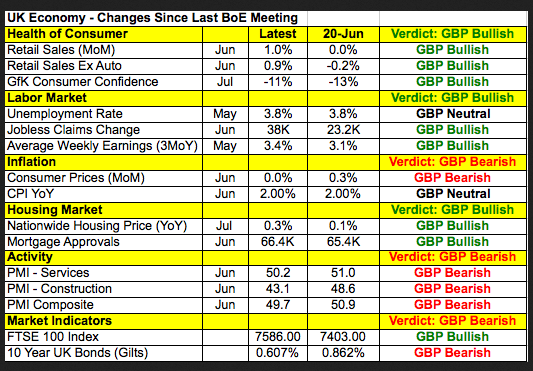Kathy Lien, Managing Director Of FX Strategy For BK Asset Management
Daily FX Market Roundup July 31, 2019
The Federal Reserve lowered interest rates by 25bp for the first time since 2008 and instead of sliding, the U.S. dollar rallied. Normally, rate cuts are negative for a currency but in the case of the Fed, investors interpreted today’s actions as positive for the currency for the following reasons:
3 Reasons Why Dollar Rallied After Fed Cut Rates
1. 2 FOMC members voted against a rate cut
2. Fed Chair Powell says rate cut isn’t necessarily start of long series of rate cuts
3. Powell focused on strength of labor market, uptick in retail sales and resilience in economy
Going into today’s monetary policy announcement the market had fully discounted a quarter-point cut with some traders looking for a more aggressive 50bp move. Instead, while the majority of the FOMC voted to cut rates, two members (George and Rosengren) preferred to leave interest rates unchanged. In yesterday’s note, we talked about how the vote was one of the most important aspects of the policy decision. On balance, the central bank was not as dovish as the market had anticipated and this bias was reinforced by Fed Chairman Powell’s comments. According to Powell, today’s rate cut was aimed at boosting inflation and insuring against downside risks because even with global uncertainty and trade concerns, the Fed feels that the outlook for the economy is favorable. Powell went out of his way to focus on the strength of the labor market, the recent uptick in retail sales and the overall resilience in the economy. Although he did cite some weakness in manufacturing, he said the economy is as close to its goals as it's been in a long time. There was no forward guidance in his prepared comments but during the Q&A session, he said this is not the start of a long easing cycle but they could cut again if the time comes.
So while today’s quarter-point cut may not be a one-and-done move for the Fed, the central bank doesn’t see a reason for an immediate follow up action. In fact, considering that Powell feels “nothing in the US economy poses a major near term threat,” he’s telling us that there may not be a need for another rate cut this year. The U.S. dollar traded higher against all of the major currencies and further gains are likely as the Fed proves to be one of the least dovish central banks.
With FOMC behind us, the focus will now shift to sterling and the Bank of England. Not only is there a monetary policy announcement on the calendar but the BoE will also be releasing their Quarterly Inflation report and updated economic projections. We know that for the central bank, it is very difficult to predict what is in store for the economy until the government decides what their exit of the European Union will look like and there’s no more clarity today than a month, 3 months or even 6 months ago.
Britain has a new Prime Minister and judging from the price action of sterling last week, investors are not impressed. His pledge fora hard line on Brexit and a commitment to the October 31 deadline for leaving the European Union makes everyone including the BoE nervous. According to the country’s new leader, “the time has come to act.” With less than 20 working Parliamentary days before the deadline, the chance that an agreement will be reached within that time is extremely slim. Although we still think that Johnson will request an extension, the EU and the Bank of England needs to weigh the growing possibility of a no-deal Brexit.
When the central bank last met in June, their concerns centered on global growth but they also said that, “if their forecasts are correct, tighter monetary policy will be needed.” Their base forecast is for a Withdrawal agreement to be reached but we may not know if that happens until the eleventh hour.
We expect the BoE to acknowledge the increased risk of a no-deal Brexit and the disruption that it could have on the market, but at the end of the day, they will not make any changes to monetary policy until the terms of exit are known. If the central bank reiterates that, “if their forecasts are correct, tighter monetary policy will be needed” and short covering will drive GBP sharply higher as the BoE would be the only major central bank talking about raising interest rates. However if rate hikes aren’t mentioned at all, sterling will extend its slide. Taking a look at the table below consumer spending and labor-market conditions improved since the last meeting but manufacturing and service sector activity slowed. Unlike other countries where inflation is running well below target, UK CPI is hovering right at 2%. Traders should also keep an eye on changes to the central bank’s growth and inflation because these may be the most definitive triggers for sterling tomorrow.

Lastly Eurozone data was mixed with German retail sales rising strongly in June and labor-market conditions in Germany are holding steady. GDP and inflation in the Eurozone slowed but none of these reports had a meaningful impact on the euro, which waited for FOMC to move lower. The Australian dollar on the other hand responded positively to stronger CPI and Chinese PMIs. Inflationary pressures increased in the second quarter by 0.6%, up from 0% in Q1. This increase was stronger than expected and drove the year over year rate to 1.6% from 1.3%. While this marked the first uptick in annualized price pressures since the second quarter of 2018, the low level of prices still leaves the door open to additional easing.
